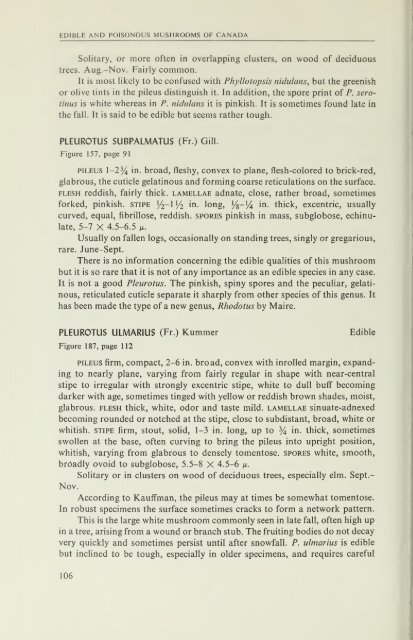You also want an ePaper? Increase the reach of your titles
YUMPU automatically turns print PDFs into web optimized ePapers that Google loves.
EDIBLE AND POISONOUS MUSHROOMS OF CANADA<br />
Solitary, or more often in overlapping clusters, on wood of deciduous<br />
trees. Aug.-Nov. Fairly common.<br />
It is most likely to be confused with Phyllotopsis nidulans, but the greenish<br />
or olive tints in the pileus distinguish it. In addition, the spore print of P. sero-<br />
tinus is white whereas in P. nidulans it is pinkish. It is sometimes found late in<br />
the fall. It is said to be edible but seems rather tough.<br />
PLEUROTUS SUBPALMATUS (Fr.) Gill.<br />
Figure 157, page 91<br />
PILEUS 1-2% in. broad, fleshy, convex to plane, flesh-colored to brick-red,<br />
glabrous, the cuticle gelatinous and forming coarse reticulations on the surface.<br />
FLESH reddish, fairly thick, lamellae adnate, close, rather broad, sometimes<br />
forked, pinkish, stipe J^-IJ^ in. long, V^-Y^ in. thick, excentric, usually<br />
curved, equal, fibrillose, reddish, spores pinkish in mass, subglobose, echinu-<br />
late, 5-7 X 4.5-6.5 /x.<br />
Usually on fallen logs, occasionally on standing trees, singly or gregarious,<br />
rare. June-Sept.<br />
There is no information concerning the edible qualities of this mushroom<br />
but it is so rare that it is not of any importance as an edible species in any case.<br />
It is not a good Pleurotus. The pinkish, spiny spores and the peculiar, gelati-<br />
nous, reticulated cuticle separate it sharply from other species of this genus. It<br />
has been made the type of a new genus, Rhodotus by Maire.<br />
PLEUROTUS ULMARIUS (Fr.) Kummer Edible<br />
Figure 187, page 112<br />
pileus firm, compact, 2-6 in. broad, convex with inrolled margin, expand-<br />
ing to nearly plane, varying from fairly regular in shape with near-central<br />
stipe to irregular with strongly excentric stipe, white to dull buff" becoming<br />
darker with age, sometimes tinged with yellow or reddish brown shades, moist,<br />
glabrous, flesh thick, white, odor and taste mild, lamellae sinuate-adnexed<br />
becoming rounded or notched at the stipe, close to subdistant, broad, white or<br />
whitish, stipe firm, stout, solid, 1-3 in. long, up to % in. thick, sometimes<br />
swollen at the base, often curving to bring the pileus into upright position,<br />
whitish, varying from glabrous to densely tomentose. spores white, smooth,<br />
broadly ovoid to subglobose, 5.5-8 X 4.5-6 /x.<br />
Solitary or in clusters on wood of deciduous trees, especially elm. Sept.-<br />
Nov.<br />
According to Kauff'man, the pileus may at times be somewhat tomentose.<br />
In robust specimens the surface sometimes cracks to form a network pattern.<br />
This is the large white mushroom commonly seen in late fall, often high up<br />
in a tree, arising from a wound or branch stub. The fruiting bodies do not decay<br />
very quickly and sometimes persist until after snowfall. P. ulmarius is edible<br />
but inclined to be tough, especially in older specimens, and requires careful<br />
106

















